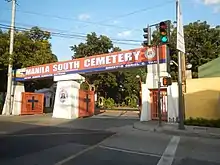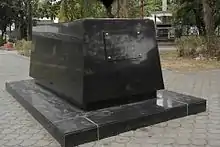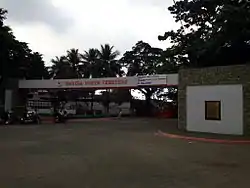Manila South Cemetery
The Manila South Cemetery is a cemetery in Metro Manila. It is an exclave of San Andres, Manila surrounded by land under the jurisdiction of the city of Makati.[1]
 Main Entrance to Manila South Cemetery | |
| Details | |
|---|---|
| Established | 1925 |
| Location | |
| Country | Philippines |
| Coordinates | 14°33′56″N 121°1′9″E |
| Type | Public |
| Owned by | City of Manila |
| Size | 25 hectares (62 acres) |
| No. of graves | 295,000 |
| Website | manila.gov.ph/south-cemetery/ |
History
The land which the cemetery occupies was previously part of the Hacienda San Pedro de Macati which was owned by the Ayala-Roxas-Zóbel family.[2][3] The land was then under the province of Rizal.[4] The South Cemetery was legally acquired by Ordinance 726 and other actions taken by the Municipal Board and Mayor Zobel vs. City of Manila (1925).[5]
The cemetery, occupying an area of 25 hectares (62 acres),[1] has a maximum capacity of 371,490 graves. On June 30, 2007. a record of 266,170 burials were made in the cemetery. There were an estimated total of 753,186 burials as of July 2018.[6]
On All Saints' Day 2015, a record 32,000 people visited the cemetery.[1]
The Manila city government under Mayor Isko Moreno in 2020 passed Ordinance No. 8608 allotting 2,400 square meters (26,000 sq ft) within the Manila South Cemetery for the establishment of the Manila Muslim Cemetery.[7] The groundbreaking ceremony for the Muslim cemetery was held on July 22, 2020.[8]
Notable burials

- Ramon Bagatsing (1916–2006), longest serving Mayor of Manila, survivor of the Plaza Miranda bombing
- Leon Guinto (1886–1962), Mayor of Manila during World War II, and Governor of Quezon
- Augusto S. Francisco, former Congressman of 4th district of Manila
- José Vicente Abad Santos brother of Jose Abad Santos -the Fifth Chief Justice of the Supreme Court of the Philippines and served as Acting President of the Philippines during World War II, which was executed by Japanese soldier in Cebu with his son Pepito.
- Elpidio Quirino (1890–1956), 6th President of the Philippines (reinterred at the Libingan ng mga Bayani on February 29, 2016)[9]
- Espiridiona Bonifacio (1875–1956), nationalist and revolutionary, and sister of Andrés Bonifacio
- Cornelia "Angge" Lee (1946–2017), talent manager, coordinator and actress
- Lucrecia Roces Kasilag (1918–2008), composer, music educator, and National Artist for Music
- Lope K. Santos (1879–1963), novelist, linguist, and grammarian of the Filipino language
- Paraluman (1923–2009), actress of the 1950s, her remains were later exhumed and moved to undisclosed location.
- Jose "Joey" D. Hizon, former congressman of Manila's 5th District
- Rafaelita Soriano (1915–2007), former ambassador, educator, scholar, researcher, historian, and Kapampangan cultural advocate
See also
References
- "In the Know: Manila South Cemetery". Philippine Daily Inquirer. 2 November 2016. Retrieved 28 August 2017.
- Gomez, Buddy (10 February 2016). "The man who saved Makati in 1943". ABS-CBN News. Retrieved 28 August 2017.
- Tan, Miguel; Mora, MG (1 November 2013). "Cemetery trivia: How well do you know our burial grounds?". Rappler. Retrieved 28 August 2017.
- "G.R. No. L-22201 - Jacobo Zobel, et. al. vs. City of Manila". LawPhil.net. Supreme Court of the Philippines. 12 January 1925.
- "Manila South Cemetery". Archived from the original on 6 December 2011. Retrieved 30 November 2011.
- "MANILA SOUTH CEMETERY". City of Manila. Archived from the original on 30 July 2018.
- "Manila approves construction of Muslim cemetery". CNN Philippines. 3 March 2020. Retrieved 19 April 2020.
- Valenzuela, Nikka (22 July 2020). "Manila breaks ground for first Muslim cemetery". Philippine Daily Inquier. Retrieved 23 July 2020.
- Gamil, Jaymee; Dizon, Nikko (28 February 2016). "After 60 years, President Quirino gets burial he deserves". Philippine Daily Inquirer. Retrieved 28 July 2019.
